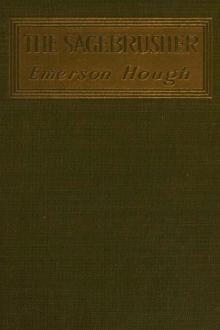The Story of the Outlaw by Emerson Hough (most read books in the world of all time .TXT) 📖

- Author: Emerson Hough
- Performer: -
Book online «The Story of the Outlaw by Emerson Hough (most read books in the world of all time .TXT) 📖». Author Emerson Hough
From precisely the same surroundings came the Younger boys, Thomas Coleman, or "Cole," Younger, and his brothers, John, Bruce, James, and Robert. Their father was Henry W. Younger, who settled in Jackson county, Missouri, in 1825, and was known as a man of ability and worth. For eight years he was county judge, and was twice elected to the state legislature. He had fourteen children, of whom five certainly were bad. At one time he owned large bodies of land, and he was a prosperous merchant in Harrisonville for some time. Cole Younger was born January 15, 1844, John in 1846, Bruce in 1848, James in 1850, and Bob in 1853. As these boys grew old enough, they joined the Quantrell bands, and their careers were precisely the same as those of the James boys. The cause of their choice of sides was the same. Jennison, the Kansas jayhawker leader, in one of his raids into Missouri, burned the houses of Younger and confiscated the horses in his livery stables. After that the boys of the family swore revenge.
At the close of the war, the Younger and James boys worked together very often, and were leaders of a band which had a cave in Clay county and numberless farm houses where they could expect shelter in need. With them, part of the time, were George and Ollie Shepherd; other members of their band were Bud Singleton, Bob Moore, Clel Miller and his brother, Arthur McCoy; others who came and went from time to time were regularly connected with the bigger operations. It would be wearisome to recount the long list of crimes these men committed for ten or fifteen years after the war. They certainly brought notoriety to their country. They had the entire press of America reproaching the State of Missouri; they had the governors of that state and two or three others at their wits' end; they had the best forces of the large city detective agencies completely baffled. They killed two detectives—one of whom, however, killed John Younger before he died—and executed another in cold blood under circumstances of repellant brutality. They raided over Missouri, Kansas, Kentucky, Tennessee, even as far east as West Virginia, as far north as Minnesota, as far south as Texas and even old Mexico. They looted dozens of banks, and held up as many railway passenger trains and as many stage coaches and travelers as they liked. The James boys alone are known to have taken in their robberies $275,000, and, including the unlawful gains of their colleagues, the Youngers, no doubt they could have accounted for over half a million dollars. They laughed at the law, defied the state and county governments, and rode as they liked, here, there, and everywhere, until the name of law in the West was a mockery. If magnitude in crime be claim to distinction, they might ask the title, for surely their exploits were unrivaled, and perhaps cannot again be equaled. And they did all of these unbelievable things in the heart of the Mississippi valley, in a country thickly settled, in the face of a long reputation for criminal deeds, and in a country fully warned against them! Surely, it seems sometimes that American law is weak.
It was much the same story in all the long list of robberies of small country banks. A member of the gang would locate the bank and get an idea of the interior arrangements. Two or three of the gang would step in and ask to have a bill changed; then they would cover the cashier with revolvers and force him to open the safe. If he resisted, he was killed; sometimes killed no matter what he did, as was cashier Sheets in the Gallatin bank robbery. The guard outside kept the citizens terrified until the booty was secured; then flight on good horses followed. After that ensued the frantic and unorganized pursuit by citizens and officers, possibly another killing or two en route, and a return to their lurking place in Clay county, Missouri, where they never had any difficulty in proving all the alibis they needed. None of these men ever confessed to a full list of these robberies, and, even years later, they all denied complicity; but the facts are too well known to warrant any attention to their denials, founded upon a very natural reticence. Of course, their safety lay in the sympathy of a large number of neighbors of something the same kidney; and fear of retaliation supplied the only remaining motive needed to enforce secrecy.
Some of the most noted bank robberies in which the above mentioned men, or some of them, were known to have been engaged were as follows: The Clay County Savings Association, of Liberty, Missouri, February 14, 1866, in which a little boy by name of Wymore was shot to pieces because he obeyed the orders of the bank cashier and gave the alarm; the bank of Alexander Mitchell & Co., Lexington, Missouri, October 30, 1860; the McLain Bank, of Savannah, Missouri, March 2, 1867, in which Judge McLain was shot and nearly killed; the Hughes & Mason Bank, of Richmond, Missouri, May 23, 1867, and the later attack on the jail, in which Mayor Shaw, Sheriff J. B. Griffin, and his brave fifteen-year-old boy were all killed; the bank of Russellville, Kentucky, March 20, 1868, in which cashier Long was badly beaten; the Daviess County Savings Bank, of Gallatin, Missouri, December 7, 1869, in which cashier John Sheets was brutally killed; the bank of Obocock Brothers, Corydon, Iowa, June 3, 1871, in which forty thousand dollars was taken, although no one was killed; the Deposit Bank, of Columbia, Missouri, April 29, 1872, in which cashier R. A. C. Martin was killed; the Savings Association, of Ste. Genevieve, Missouri; the Bank of Huntington, West Virginia, September 1, 1875, in which one of the bandits, McDaniels, was killed; the Bank of Northfield, Minnesota, September 7, 1876, in which cashier J. L. Haywood was killed, A. E. Bunker wounded, and several of the bandits killed and captured as later described.
These same men or some of them also robbed a stage coach now and then; near Hot Springs, Arkansas, for example, January 15, 1874, where they picked up four thousand dollars, and included ex-Governor Burbank, of Dakota, among their victims, taking from him alone fifteen hundred dollars; the San Antonio-Austin coach, in Texas, May 12, 1875, in which John Breckenridge, president of the First National Bank of San Antonio, was relieved of one thousand dollars; and the Mammoth Cave, Kentucky, stage, September 3, 1880, where they took nearly two thousand dollars in cash and jewelry from passengers of distinction.
The most daring of their work, however, and that which brought them into contact with the United States government for tampering with the mails, was their repeated robbery of railway mail trains, which became a matter of simplicity and certainty in their hands. To flag a train or to stop it with an obstruction; or to get aboard and mingle with the train crew, then to halt the train, kill any one who opposed them, and force the opening of the express agent's safe, became a matter of routine with them in time, and the amount of cash they thus obtained was staggering in the total. The most noted train robberies in which members of the James-Younger bands were engaged were the Rock Island train robbery near Council Bluffs, Iowa, July 21, 1873, in which engineer Rafferty was killed in the wreck, and but small booty secured; the Gad's Hill, Missouri, robbery of the Iron Mountain train, January 28, 1874, in which about five thousand dollars was secured from the express agent, mail bags and passengers; the Kansas-Pacific train robbery near Muncie, Kansas, December 12, 1874, in which they secured more than fifty-five thousand dollars in cash and gold dust, with much jewelry; the Missouri-Pacific train robbery at Rocky Cut, July 7, 1876, where they held the train for an hour and a quarter and secured about fifteen thousand dollars in all; the robbery of the Chicago & Alton train near Glendale, Missouri, October 7, 1879, in which the James boys' gang secured between thirty-five and fifty thousand dollars in currency; the robbery of the Rock Island train near Winston, Missouri, July 15, 1881, by the James boys' gang, in which conductor Westfall was killed, messenger Murray badly beaten, and a passenger named MacMillan killed, little booty being obtained; the Blue Cut robbery of the Alton train, September 7, 1881, in which the James boys and eight others searched every passenger and took away a two-bushel sack full of cash, watches, and jewelry, beating the express messenger badly because they got so little from the safe. This last robbery caused the resolution of Governor Crittenden, of Missouri, to take the bandits dead or alive, a reward of thirty thousand dollars being arranged by different railways and express companies, a price of ten thousand dollars each being put on the heads of Frank and Jesse James.
Outside of this long list of the bandit gang's deeds of outlawry, they were continually in smaller undertakings of a similar nature. Once they took away ten thousand dollars in cash at the box office of the Kansas City Fair, this happening September 26, 1872, in a crowded city, with all the modern machinery of the law to guard its citizens. Many acts at widely separated parts of the country were accredited to the Younger or the James boys, and although they cannot have been guilty of all of them, and, although many of the adventures accredited to them in Texas, Mexico, California, the Indian Nations, etc., bear earmarks of apocryphal origin, there is no doubt that for twenty years after the close of the civil war they made a living in this way, their gang being made up of perhaps a score of different men in all, and usually consisting of about six to ten men, according to the size of the undertaking on hand.
Meantime, all these years, the list of homicides for each of them was growing. Jesse James killed three men out of six who attacked his house one night, and not long after Frank and he are alleged to have killed six men in a gambling fight in California. John and Jim Younger killed the Pinkerton detectives Lull and Daniels, John being himself killed at that time by Daniels. A little later, Frank and Jesse James and Clel Miller killed detective Wicher, of the same agency, torturing him for some time before his death in the attempt to make him divulge the Pinkerton plans. The James boys killed Daniel Askew in revenge; and Jesse James and Jim Anderson killed Ike Flannery for motives of robbery. This last set the gang into hostile camps, for Flannery was a nephew of George Shepherd. Shepherd later killed Anderson in Texas for his share in





Comments (0)